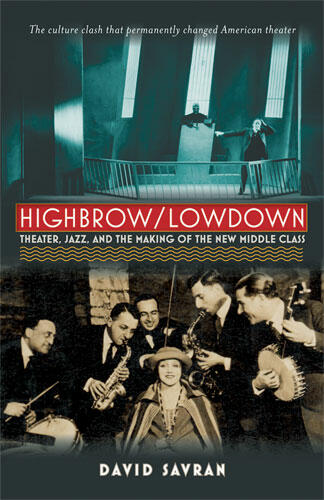Highbrow/Lowdown
Theater, Jazz, and the Making of the New Middle Class
The culture clash that permanently changed American theater
Description
"An elegant, erudite, and thorough study . . . The venture into music history and the impact, both positive and negative, of jazz on culture, and especially the emergence of a literary art theater, is the book's most obvious unique contribution . . . the analysis of the place of various critics and the audience in a period of major cultural change involving class, race, and ethnicity is especially welcome."
---Choice
"Highbrow/Lowdown stakes out the secret history of how that yawning abyss between mass culture and serious theatre came about---a dynamic that still plays out to this day both in the commercial and resident theatres. This intellectual study, a revelatory blending of music criticism and drama history, delves into the critical and artistic antagonisms between jazz and classical music, the serious and lively arts, as well as the old and new middle-class tastes."
---American Theatre
"A book about the fracturing of the theater audience in the 1920s using jazz as a lens. [Savran] points to jazzy composers such as Gershwin, who never got his due while he was writing because of his embrace of jazz . . . What is intriguing about Savran's book is how these class distinctions still hold true today."
---All About Jazz
Highbrow/Lowdown explores the twentieth century's first culture war and the forces that permanently transformed American theater into the art form we know today. The arrival of jazz in the 1920s sparked a cultural revolution that was impossible to contain. The music affected every stratum of U.S. society and culture, confusing and challenging long-entrenched hierarchies based on class, race, and ethnicity. But jazz was much more than the music---it was also a powerful cultural force that brought African American, Jewish, and working-class culture into the white Protestant mainstream. When the influence of jazz spread to legitimate theater, playwrights, producers, and critics rushed to distinguish the newly emerging literary theater from its illegitimate cousins. The efforts to defeat the democratizing influences of jazz and to canonize playwrights like Eugene O'Neill triumphed, giving birth to American theater as we know it today.
David Savran is Distinguished Professor of Theatre and Vera Mowry Roberts Chair in American Theatre at the Graduate Center, City University of New York.
David Savran is Distinguished Professor of Theatre and Vera Mowry Roberts Chair in American Theatre at the Graduate Center, City University of New York.
Reviews
Honorable Mention: American Society for Theatre Research (ASTR) 2010 Barnard Hewitt Award
- ASTR Barnard Hewitt Award
Supplemental Materials
Sample Audio Tracks
Author David Savran has selected a series of musical compositions especially for this site, that he feels help to identify some important trends discussed in the book. Read the descriptions below and click the links to hear a clip of each song.
Fred Astaire, "Fascinating Rhythm" from At the Movies
NOTE: The big hit from Lady, Be Good!, the Gershwins' first Broadway smash, "Fascinating Rhythm."
Caroll Gibbons & The New Mayfair Dance Orchestra, "Crazy Rhythm" from The Charleston
NOTE: "Crazy Rhythm," the 1928 song by Roger Wolfe Kahn and Irving Caesar that explains what happens when a highbrow meets a lowbrow.
Various Artists - AVID Entertainment, "Sweet And Low-down", from George Gershwin - A Celebration: Fascinating Rhythm
NOTE: The big hit from Tip-Toes, the Gershwins' 1925 hit, "Sweet And Low-down."
Various Artists - AVID Entertainment, "When Do We Dance?", from George Gershwin - A Celebration: Fascinating Rhythm
NOTE: "When Do We Dance?" from Tip-Toes.
Various Artists - AVID Entertainment, "These Charming People", from George Gershwin - A Celebration: Fascinating Rhythm
NOTE: "These Charming People" from Tip-Toes.
Michael Tilson Thomas; Garrick Ohlsson, "Concerto in F for Piano and Orchestra/Allegro," from Gershwin: Rhapsody in Blue; Concerto in F; An American in Paris: Classic Library Series
NOTE: George Gershwin's Concerto in F, the work that proved that he could write serious concert music.
Ballet Pour instruments Mecanique et Percussion, Roll One
The New Palais Royale Orchestra & Percussion Ensemble, Maurice Peress, "Ballet Pour Instruments Mecanique et Percussion, Roll One," from The Original Ballet Mechanique - George Antheil's Carnegie Hall Concert of 1927
NOTE: George Antheil's Ballet mecanique, the most scandalous and revolutionary piece of music of the 1920s.
Vaughn De Leath, "I'm Just Wild About Harry," from Ukulele Lady
NOTE: "I'm Just Wild About Harry," by Eubie Blake and Noble Sissle, the big hit of Shuffle Along.
Michael Tilson Thomas, "Rhapsody in Blue," from Gershwin: Rhapsody in Blue; Concerto in F; An American in Paris: Classic Library Series
NOTE: George Gershwin's Rhapsody in Blue (1924), the piece that changed American music forever.
News, Reviews, Interviews
Read: Review on All About Jazz | 8/25/09
Read: Review on Jazz Times | 12/01/09

